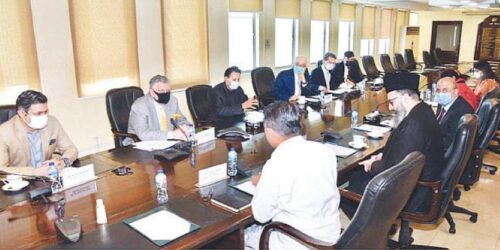The government on Tuesday appeared set to increase the electricity tariff it had put on hold in April as part of revised Circular Debt Management Plan (CDMP) and efforts to ensure continuous foreign inflows from lending agencies – particularly the IMF, the World Bank and the Asian Development Bank.
The tariff increase along with CDMP is expected to set into motion from Oct 1, but has to be discussed in detail by the Economic Coordination Committee (ECC) of the Cabinet within a few days. The tariff increases would be made through quarterly adjustments and surcharges in a phased manner.
To shape up the exact size of tariff increase along with other measures to contain and reduce circular debt, Finance Minister Shaukat Tarin, Energy Minister Hammad Azhar, SAPM on Power and Petroleum Tabish Gauhar and secretaries of finance and power besides other senior officials of the two divisions had a detailed discussions on Tuesday.
Mr Tarin, Azhar and Gohar did not respond to calls for comments.
Tarin tells energy ministry team to ‘adopt forward planning while dealing with volatile energy prices in international markets’
“We want a final shape of the CDMP shared with the IMF and the World Bank by next weekend to have some sort of understanding within 15 days,” a senior government official told Dawn.
He said it was important that when Finance Minister Shaukat Tarin visits Washington early next month for Oct 11-17 World Bank-IMF annual meetings, the Ministry of Finance and IMF staff are on the same page regarding the revival of $6bn IMF programme currently in recess.
The official said the World Bank executive board would separately be meeting in the last week of this month to approve three different programme loans, particularly the $400 million energy sector loan. He said various scenarios were discussed including the full revival of tariff increase plan committed with the IMF and the subsequent challenges arising out of increasing size of fuel cost adjustments (FCA), partly because of record high LNG prices, on a monthly basis.
“Definitely the consumers are in double jeopardy in the shape of base tariff increase when FCAs are ranging between Re1 to Rs1.50 per month,” the official conceded, adding the government has so far been advocating 18-20pc increase in industrial electricity consumption because of cheaper rates on incremental consumption as a success story to address power surplus challenge but “you have to take a decision at some point”.
After committing about Rs5.65 per unit increase in power tariff with IMF early this year to generate about Rs900bn by June 2023, the government increased tariff by about Rs2 per unit early this year and backtracked from second round of Rs1.40 per unit with effect from April 1. In the heat of such tariff increases, Prime Minister Imran Khan replaced Dr Abdul Hafeez Shaikh with Shaukat Tarin as finance minister.
The official said the target to generate Rs900bn through tariff adjustments till June 2023 remained unchanged as in the original CDMP agreed with the IMF and the World Bank last year. The schedule and size of adjustments may be slightly different, he said.
A Finance Ministry statement quoted the finance minister as telling the team of energy ministry led by Mr Azhar to “adopt forward planning while dealing with the volatile energy prices in international markets and also emphasised the importance of risk hedging to dampen the impact of recent fluctuations in global prices of crude oil and petroleum products particularly due to supply side disruptions amid Covid-19 pandemic”.
The finance minister “also stressed upon exploring cost-effective options such as renewable sources of energy for a sustainable energy equation by reducing reliance on expensive power producing plants in order to make the energy sector dynamic and sustainable”.
The energy minister explained growing demand for energy, installed generation capacity, transmission capability and also outlined steps being taken for improving transmission and distribution systems for reducing costs and ensuring sustainability, the statement said.
Mr Tarin said the government was cognizant of its obligation to fulfill energy requirements at affordable rates for electricity consumers and was taking all possible measures to meet future energy demands.
Under the plan committed with the IMF, the power sector was to get an additional financial injection of Rs2.650 trillion in two years. This included Rs1.060tr revenue generation through various tariff adjustments and rebasing and by the government (40pc contribution), followed by Rs850bn worth of governance, efficiency and recovery efforts of the Power Division (32pc) and Rs740bn by the Finance Division (28pc) through realistic allocation and timely payment of subsidies.
Similarly, the Power Division was responsible to put together Rs850bn through 5.73pc improvement in overall recovery of billing (Rs205bn), for 2.12pc reduction in system losses (Rs130bn), reduction in IPPs markup on stock payments (Rs67bn), impact of reduction in return on equity secured from IPPs (Rs146bn) and payment by KE worth Rs303bn including Rs127bn starting with July 2021 and Rs175bn in FY23.






